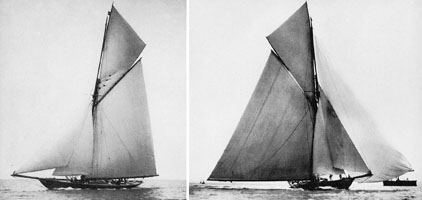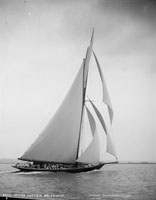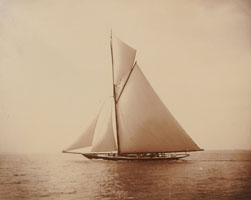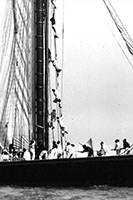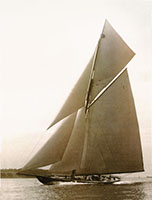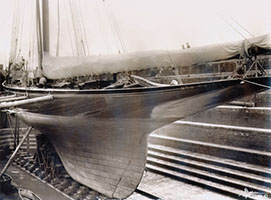Scottish designer George Lennox Watson received a commission from Prince Albert Edward for a sailing yacht in 1892. He designed His Royal Highness' Yacht Britannia to the "Length And Sail Area Rule" as a First Class cutter and had her built alongside his America's Cup challenger Valkyrie II at the D&W Henderson shipyard on the River Clyde. She was launched on April 20, 1893, a week ahead of Valkyrie II.
By the end of her first year's racing, Britannia had scored thirty-three wins from forty-three starts. In her second season, she won all seven races for the first class yachts on the French Riviera, and then beat the 1893 America's Cup defender Vigilant in home waters. In the Mount's Bay Regatta of July 28, 1894 the Vigilant owned by Mr. Jay Gould, Director of the American Cable Company was piloted by Benjamin Nicholls of Penzance and the Prince of Wales's (later Edward Vll) yacht Britannia was piloted by Ben's brother Philip Nicholls. The Britannia won by just over 7 minutes. People came by train from all over the south west to watch this race. Both brothers were Trinity House pilots of Penzance.
Despite a lull in big yacht racing after 1897, Britannia served as a trial horse for Sir Thomas Lipton's first America's Cup challenger Shamrock, and later passed on to several owners in a cruising trim with raised bulwarks. In 1920,[1] King George V triggered the revival of the "Big Class" by announcing that he would refit Britannia for racing. Although Britannia was the oldest yacht in the circuit, regular updates to her rig kept her a most successful racer throughout the 1920s. In 1931, she was converted to the J-Class with a bermuda rig, but despite the modifications, her performance to windward declined dramatically. Her last race was at Cowes in 1935. During her racing career she had won 231 races and took another 129 flags.
King George V's dying wish was for his beloved yacht to follow him to the grave. On 10 July 1936, after Britannia had been stripped of her spars and fittings, her hull was towed out to St Catherines Deep near the Isle of Wight, and she was sunk by HMS Winchester, commanded by Captain W.N.T. Beckett RN. This fate marked the end of big yacht racing in Europe, with the smaller and more affordable International Rule 12-Metre Class gaining popularity.
Two known examples of Britannia's racing flags are preserved, one presented by Sir Philip Hunloke to the Royal Cornwall Yacht Club, in whose Regattas Britannia was often a competitor between 1894 and 1935, and at the Royal St. George Yacht Club, which held two regattas in Kingstown for the first season of the RYA linear rating rule in 1896. Britannia's skipper William G. Jameson had lost both races to the new Meteor II and the Ailsa. Britannia's 51' long gaff, the king’s chair, tiller, some mast hoops, blocks and rigging, anchor chain and clock are preserved in the Sir Max Aitken Museum in Cowes High Street and the remains of her spinnaker boom are at Carrisbroke Castle, also on the Isle of Wight. The spinnaker boom was given for use as a flag pole on the keep (where it twice suffered lightning damage), and the present flagpole is a fibreglass replica.
In 1994 a replica of Britannia was approved and laid down in Russia for a Norwegian owner. She is undergoing fitout in Cowes where she is planned to be rigged according to her 1931 J-Class specifications
